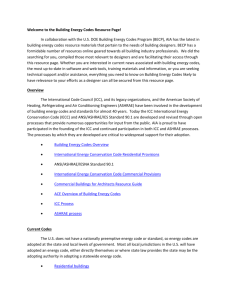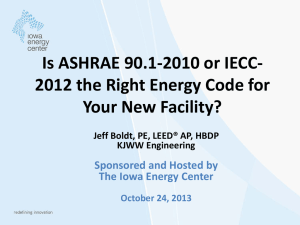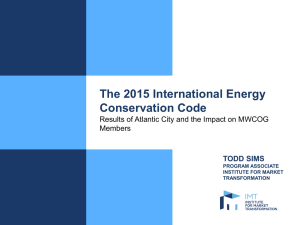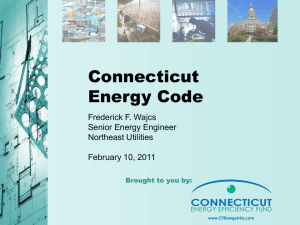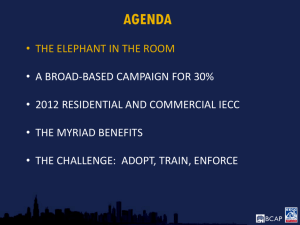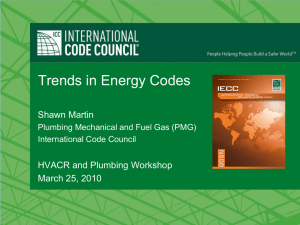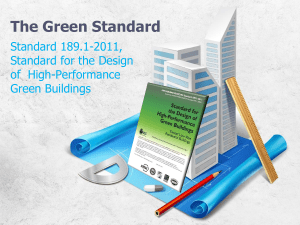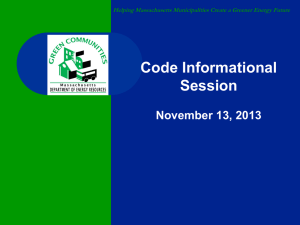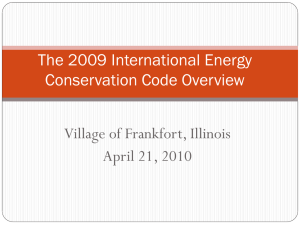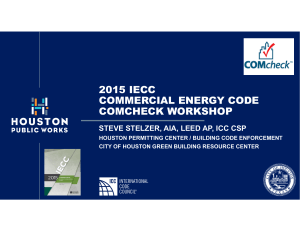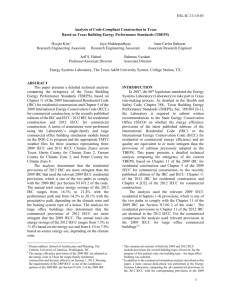SUMMER IS COMING - Utah Energy Conservation Coalition
advertisement
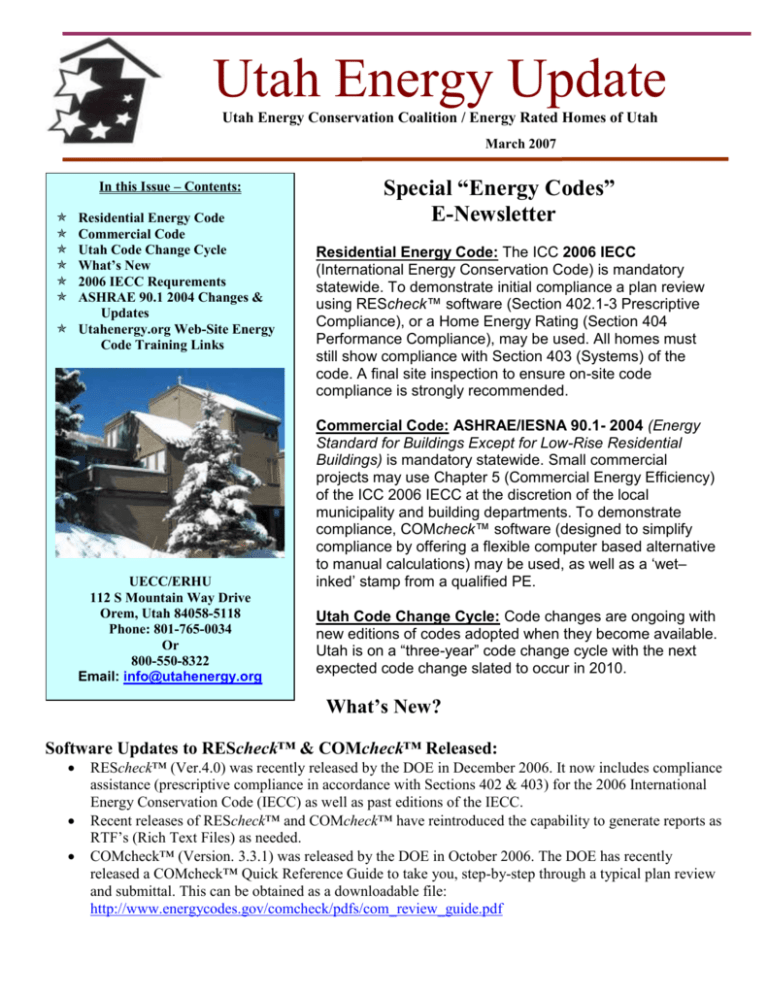
Utah Energy Update Utah Energy Conservation Coalition / Energy Rated Homes of Utah March 2007 In this Issue – Contents: Residential Energy Code Commercial Code Utah Code Change Cycle What’s New 2006 IECC Requrements ASHRAE 90.1 2004 Changes & Updates Utahenergy.org Web-Site Energy Code Training Links UECC/ERHU 112 S Mountain Way Drive Orem, Utah 84058-5118 Phone: 801-765-0034 Or 800-550-8322 Email: info@utahenergy.org Special “Energy Codes” E-Newsletter Residential Energy Code: The ICC 2006 IECC (International Energy Conservation Code) is mandatory statewide. To demonstrate initial compliance a plan review using REScheck™ software (Section 402.1-3 Prescriptive Compliance), or a Home Energy Rating (Section 404 Performance Compliance), may be used. All homes must still show compliance with Section 403 (Systems) of the code. A final site inspection to ensure on-site code compliance is strongly recommended. Commercial Code: ASHRAE/IESNA 90.1- 2004 (Energy Standard for Buildings Except for Low-Rise Residential Buildings) is mandatory statewide. Small commercial projects may use Chapter 5 (Commercial Energy Efficiency) of the ICC 2006 IECC at the discretion of the local municipality and building departments. To demonstrate compliance, COMcheck™ software (designed to simplify compliance by offering a flexible computer based alternative to manual calculations) may be used, as well as a ‘wet– inked’ stamp from a qualified PE. Utah Code Change Cycle: Code changes are ongoing with new editions of codes adopted when they become available. Utah is on a “three-year” code change cycle with the next expected code change slated to occur in 2010. What’s New? Software Updates to REScheck™ & COMcheck™ Released: REScheck™ (Ver.4.0) was recently released by the DOE in December 2006. It now includes compliance assistance (prescriptive compliance in accordance with Sections 402 & 403) for the 2006 International Energy Conservation Code (IECC) as well as past editions of the IECC. Recent releases of REScheck™ and COMcheck™ have reintroduced the capability to generate reports as RTF’s (Rich Text Files) as needed. COMcheck™ (Version. 3.3.1) was released by the DOE in October 2006. The DOE has recently released a COMcheck™ Quick Reference Guide to take you, step-by-step through a typical plan review and submittal. This can be obtained as a downloadable file: http://www.energycodes.gov/comcheck/pdfs/com_review_guide.pdf “Code Notes” Help Building Professionals: In order to better assist building professionals to obtain and understand compliance with all energy codes, the DOE has developed “Code Notes”. They are designed to help builders obtain code compliance of energy-efficient technologies. They are available to view and download as PDFs from the Building Energy Codes Program (BECP) Resource Center at www.energycodes.gov/support/code_notes.stm. The topics that are covered deal with both residential and commercial construction practices and are not climate specific. The topics addressed in these “Code Notes” are as follows: Residential: Single Top Plates Details for Mechanically Vented Crawl Spaces Drywall Clips Header Hangers in Bearing Walls No Headers in Nonbearing Walls Open Spaces as Return-Air-Options Rigid Board Insulation Installed as Draft Stop in Attic Kneewall Whole-House Mechanical Ventilation, and Ventilation Requirements for Condensing Clothes Dryers Commercial: Commercial Air Barrier Requirements for Insulated Ceilings, and Updated ANSI/ASHRAE Standard for Commercial Ventilation Rate Procedures 2006 International Energy Conservation Code – Requirements for Residential Buildings The International Code Council (ICC) has recently issued the 2006 edition of the International Energy Conservation Code (IECC). Internationally, code officials recognize the need for a modern, up-to-date residential energy conservation code addressing the design of energy efficient building envelopes and installation of energy efficient mechanical, lighting, and power systems through performance based compliance. The requirements for residential buildings in the 2006 IECC are largely the same as those in the 2003 IECC. One of the biggest changes to the IECC is the simplification of the climate zones (now only 3 climate zones – Zone 3, 5, & 6 for the state of Utah). Other changes to the code are minor and may have little or no effect on code stringency. The 2006 IECC is a comprehensive energy conservation code that establishes minimum design and construction parameters for energy-efficient buildings using prescriptive and performance based provisions. The 2006 IECC has been refined and simplified from past editions in response to recent comments and expressed needs of the numerous building officials and the housing industry. It establishes minimum thermal performance requirements for building envelopes including windows, and sets minimum efficiencies for mechanical systems in buildings. As with previous editions of the IECC, the 2006 IECC continues to reference ASHRAE/IES 90.1 for high-rise residential and commercial buildings. The 2006 IECC even includes a chapter with user-friendly language that directly addresses simple commercial buildings (Chapter 5). As required by the Energy Policy and Conservation Act (EPAct), the US Department of Energy (DOE) certified the 2006 IECC as the most cost-effective minimal residential energy-efficiency standard currently available. True compliance with the 2006 IECC goes beyond that of a preliminary plan review. Site visits (energy specific as well as inspections combined with other issues pertaining to the construction of the dwelling) and performance testing work hand-in-hand to ensure that all homes built in the state of Utah are in compliance with the 2006 IECC irregardless of climate zones. It is very important to understand that the 2006 IECC is a minimum standard of energy efficiency. Compliance with the 2006 IECC does not automatically guarantee a house to be ‘energy efficient.’ ASHRAE 90.1 (2004) Commercial Energy Code – Changes and Updates ASHRAE 90.1-2004 is designed as a standard to guide engineers and facility executives toward specifying a higher (but easily attainable) level of energy efficiency. ASHRAE 90.1-2004 incorporates all the latest upgrades (ASHRAE calls these “Addenda”), made since the publication of ASHRAE 90.1-2001. ASHRAE 90.1 2004 has been written to allow easy incorporation into specifications for new buildings and renovations while laying out minimum requirements for a building’s envelope, electrical power systems and equipment, lighting, heating, ventilating and air conditioning, service, water heating, and energy management. Among the changes seen in ASHRAE 90.1-2004 are many clarifications of requirements as well as a major reformatting of the text and a more consistent numbering scheme. One improvement has been a reduction in the number of climate zones (which affect choices of equipment) from 26 to eight. Those zones are now specified by county boundaries, eliminating difficulty where previous zone boundaries cut across political jurisdictions. This reduction also reduced the number and complexity of tables in the standard. The new standard also lowers lighting densities to reflect improvements in lighting systems and controls. An initial energy analysis of ASHRAE 90.1 2004 has found that the new code is overall 5% to 15% more stringent than the 1999 version. A major portion of this is the change in lighting densities and increased clarification of lighting systems and controls. The lighting requirements are estimated to be 25% more stringent than in past editions of the standard. http://www.utahenergy.org Web-Site Energy Code Training Links The Utah Energy Conservation Coalition has compiled a set of training and educational resources and links to assist the residents of the state of Utah in obtaining compliance with the 2006 IECC as well as ASHRAE 90.1 2004. These resources are available for direct download from www.utahenergy.org. They are available in a variety of formats (MS Word, Corel Word Perfect, Adobe Acrobat PDF, as well as MS Power Point). The resources that are currently available are: Fast Facts on the 2006 AC Standards (Adobe PDF, MS Word) 2006 IECC Residential Training (MS Power Point) ASHRAE 90.1 2004 (Adobe PDF, MS Power Point) ASHARE 90.1 2004 – Lighting Specific (MS Power Point) Guide to Sealing Air Leaks in Utah (IECC 2006) (MS Word, Adobe PDF) Guiding the Light – ASHRAE 90.1 2004 (MS Word) New HVAC Standards – Impact on Building Codes (MS Word, Adobe PDF) Residential Compliance FAQ’s to IECC 2006 (MS Word) Utah 2006 IECC Energy Code Tool Kit/Site Guide (Corel Word Perfect) CODES & HERS 2007 (MS Word) Envision Utah Chapter 7 (Energy Efficiency) (Adobe PDF) Additional information regarding both the 2006 IECC as well as ASHRAE 90.1 2004 can be found on the Internet on the following links: www.energycodes.gov http://www.energycodes.gov/news/sts/pdfs/standard_january07.pdf http://www.energycodes.gov/news/ http://www.energycodes.gov/training/onlinetraining/residential_2006IECC.stm http://www.iccsafe.org/news/nr/2006/1130RPE-exam.html http://www.bcap-energy.org/home.php http://www.bcap-energy.org/energy_activity.php http://www.bcap-energy.org/code_status.php?STATE_AB=UT http://utahenergy.org/energy_codes.html http://utahenergy.org/links.html http://www.natresnet.org/ratings/codes/brochure/hers_benefits.pdf http://geology.utah.gov/sep/energy_efficiency/energycodes.htm This is not an exhaustive list of web sites nor available information related to the 2006 IECC and ASHRAE 90.1 2004. As a brief disclaimer, the Utah Energy Conservation Coalition does not guarantee that these links will remain active or applicable over time. At the time of the issuance of this e-newsletter, these links were all active and accurate.
